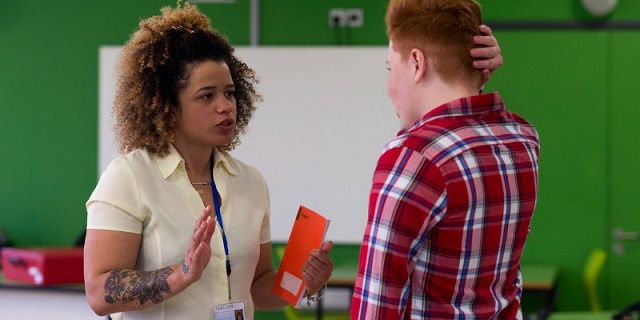Education
School board trustees should embrace genuine diversity and avoid unnecessary legal fights

From the Fraser Institute
Too many Canadian school boards are getting sidetracked by unnecessary legal battles rather than focusing on educating students.
Case in point, Carolyn Burjoski, a former teacher in the Waterloo Region District School Board (WRDSB), recently won a decisive legal victory when Justice James Ramsay rejected WRDSB’s attempt to quash Burjoski’s defamation lawsuit and awarded her $30,000 in legal fees.
Burjoski had sued her former employer because the board chair publicly accused her of transphobic behaviour for raising concerns during a board meeting about the sexualized content in a number of school library books. His public attacks on Burjoski exposed the school board to a defamation lawsuit.
In his decision, Justice Ramsay found that the WRDSB chair “acted with malice or at least a reckless disregard for the truth.” Furthermore, Ramsay explained, nothing Burjoski said during the meeting could reasonably be described as transphobic. Given these facts, it comes as little surprise that the judge ruled decisively in Burjoski’s favour.
Things could have been handled much better by the board. Had the trustees stayed focused on education, they likely would not have gotten sidetracked by Burjoski’s comments. They could have simply thanked Burjoski for her input then gotten back to work on education policy. Instead, the board chair picked a fight with one of his own teachers and led his fellow trustees into a losing legal battle. No one can seriously think this was in the best interest of students, particularly since school taxes were spent on legal fees rather than classroom resources.
Sadly, WRDSB is far from the only school board where trustees are distracted by non-educational issues. In Winnipeg’s Louis Riel School Board, trustee Francine Champagne was suspended three times in one year for making controversial social media posts and failing to submit paperwork. The board even filed a legal application to have Champagne removed from office for allegedly violating the Public Schools Act. However, Champagne resigned before the court case began, which was fortunate for the board, since it no doubt saved them considerable money in legal fees.
Parents and other taxpayers don’t elect school trustees just so their hard-earned tax dollars can be squandered on legal fees. Getting into unnecessary legal fights is a bad idea for any school board.
Fortunately, it’s not difficult for school boards to stay out of court. Refrain from defaming employees who make presentations at public meetings, stay focused on educational basics, and allow for diversity of thought on controversial issues. A board that does these things will save money in legal fees, and have a better learning environment for students.
Besides, there are real issues to be addressed in public education. For example, data from the Programme for Student Assessment (PISA) shows that academic achievement is on the decline across Canada, particularly in reading and math. If students don’t learn these fundamental skills in school, not much else that happens there will matter. Improving classroom instruction should be a top priority for every school board.
Trustees would also be wise to crack down on the growing incidents of violence in many schools. Empowering teachers and principals to remove persistently disruptive students from the classroom is essential. Teachers must know that their employers have their backs when dealing with tough situations. Safe and orderly classrooms are a prerequisite to student learning.
And when controversial issues do come up during board meetings, trustees should take a measured approach and acknowledge that Canadians (including many of their own employees) hold a variety of views on topics such as how much gender and sexuality content should be in library books accessible to children. There’s no need to force everyone into the same mold.
If trustees are serious about promoting diversity, they must remember that this includes diversity of thought, not just diversity of appearance. Genuine diversity means that everyone, students and teachers alike, are free to express different opinions without fear of negative repercussions.
Education suffers when school trustees lose sight of their primary mission. The lessons learned by WRDSB and other embattled school boards should be a clear sign to trustees across Canada—stay focused on educating students.
Author:
Education
Johns Hopkins University Announces Free Tuition For Most Students


From the Daily Caller News Foundation
Johns Hopkins University (JHU) announced on Thursday it is making tuition free for families earning less than $200,000 and will waive both tuition and living expenses for those making less than $100,000.
The university stated that “a majority of American families” will qualify for the fee exemption, allowing most students to attend without contributing a single dollar. The decision is meant to help recruit “the best and brightest students to Johns Hopkins irrespective of their financial wherewithal.”
“Trying to understand financial aid offers can be overwhelming,” David Phillips, vice provost for admissions and financial aid at JHU, said in the announcement. “A big goal here is to simplify the process. We especially want to reach students and families from disadvantaged backgrounds, rural locations, and small towns across America who may not know that a Hopkins degree is within reach.”
Dear Readers:
As a nonprofit, we are dependent on the generosity of our readers.
Please consider making a small donation of any amount here.
Thank you!
In 2018, Michael Bloomberg donated nearly $2 billion to the university, the largest ever single gift to a U.S. university. JHU said it used this money “to become permanently need blind and no-loan in financial aid.”
The university also receives the most federal funding of any university, raking in more than $3 billion from the government in fiscal year 2023 for research and development alone. This is more than double what the next highest recipient of federal funding that year, the University of Washington, received.
Despite this, JHU in June complained that federal funding cuts forced it to institute a hiring freeze and pause annual pay increases for employees. In its message to the community at the time, the university also mentioned its disagreement with “recent efforts to limit or withhold visas from the international students and scholars.”
Some universities admit mass numbers of foreign students in order to pad their pockets, as such students often pay full tuition and fee costs without financial assistance.
Education
Why classroom size isn’t the issue teacher unions think it is

This article supplied by Troy Media.
The real challenge is managing classrooms with wide-ranging student needs, from special education to language barriers
Teachers’ unions have long pushed for smaller class sizes, but the real challenge in schools isn’t how many students are in the room—it’s how complex those classrooms have become. A class with a high proportion of special needs students, a wide range of academic levels or several students learning English as a second language can be far more difficult to teach than a larger class
where students are functioning at a similar level.
Earlier this year, for example, the Elementary Teachers’ Federation of Ontario announced that smaller class sizes would be its top bargaining priority in this fall’s negotiations.
It’s not hard to see why unions want smaller classes. Teaching fewer students is generally easier than teaching more students, which reduces the workload of teachers. In addition, smaller classes require hiring more teachers, and this amounts to a significant financial gain for teachers’ unions. Each teacher pays union dues as part of membership.
However, there are good reasons to question the emphasis on class size. To begin with, reducing class size is prohibitively expensive. Teacher salaries make up the largest percentage of education spending, and hiring more teachers will significantly increase the amount of money spent on salaries.
Now, this money could be well spent if it led to a dramatic increase in student learning. But it likely wouldn’t. That’s because while research shows that smaller class sizes have a moderately beneficial impact on the academic performance of early years students, there is little evidence of a similar benefit for older students. Plus, to get a significant academic benefit, class sizes need to be reduced to 17 students or fewer, and this is simply not financially feasible.
In addition, not only does reducing class sizes mean spending more money on teacher compensation (including salaries, pensions and benefits), but it also leads to a decline in average teacher experience and qualifications, particularly during teacher shortages.
As a case in point, when the state of California implemented a K-3 class-size reduction program in 1996, inexperienced or uncertified teachers were hired to fill many of the new teaching positions. In the end, California spent a large amount of money for little measurable improvement in academic performance. Ontario, or any other province, would risk repeating California’s costly experience.
Besides, anyone with a reasonable amount of teaching experience knows that classroom complexity is a much more important issue than class size. Smaller classes with a high percentage of special needs students are considerably more difficult to teach than larger classes where students all function at a similar academic level.
The good news is that some teachers’ unions have shifted their focus from class size to classroom complexity. For example, during the recent labour dispute between the Saskatchewan Teachers’ Federation (STF) and the Saskatchewan government, the STF demanded that a classroom complexity article be included in the provincial collective agreement. After the dispute went to binding arbitration, the arbitrator agreed with the STF’s request.
Consequently, Saskatchewan’s new collective agreement states, among other things, that schools with 150 or more students will receive an additional full-time teacher who can be used to provide extra support to students with complex needs. This means that an extra 500 teachers will be hired across Saskatchewan.
While this is obviously a significant expenditure, it is considerably more affordable than arbitrarily reducing class sizes across the province. By making classroom complexity its primary focus, the STF has taken an important first step because the issue of classroom complexity isn’t going away.
Obviously, Saskatchewan’s new collective agreement is far from a panacea, because there is no guarantee that principals will make the most efficient use of these additional teachers.
Nevertheless, there are potential benefits that could come from this new collective agreement. By getting classroom complexity into the collective agreement, the STF has ensured that this issue will be on the table for the next round of bargaining. This could lead to policy changes that go beyond hiring a few additional teachers.
Specifically, it might be time to re-examine the wholesale adoption of placing most students, including those with special needs, in regular classrooms, since this policy is largely driving the increase in diverse student needs. While every child has the right to an education, there’s no need for this education to look the same for everyone. Although most students benefit from being part of regular academic classes, some students would learn better in a different setting that takes their individual needs into consideration.
Teachers across Canada should be grateful that the STF has taken a step in the right direction by moving beyond the simplistic demand for smaller class sizes by focusing instead on the more important issue of diverse student needs.
Michael Zwaagstra is a senior fellow with the Frontier Centre for Public Policy.
Troy Media empowers Canadian community news outlets by providing independent, insightful analysis and commentary. Our mission is to support local media in helping Canadians stay informed and engaged by delivering reliable content that strengthens community connections and deepens understanding across the country
-

 Business2 days ago
Business2 days agoBlacked-Out Democracy: The Stellantis Deal Ottawa Won’t Show Its Own MPs
-

 Agriculture2 days ago
Agriculture2 days agoHealth Canada pauses plan to sell unlabeled cloned meat
-

 Crime2 days ago
Crime2 days agoB.C.’s First Money-Laundering Sentence in a Decade Exposes Gaps in Global Hub for Chinese Drug Cash
-

 Crime2 days ago
Crime2 days agoFBI Seizes $13-Million Mercedes Unicorn From Ryan Wedding’s Narco Network
-

 Banks2 days ago
Banks2 days agoThe Bill Designed to Kill Canada’s Fossil Fuel Sector
-

 International2 days ago
International2 days agoAmerica first at the national parks: Trump hits Canadians and other foreign visitors with $100 fee
-

 armed forces1 day ago
armed forces1 day ago2025 Federal Budget: Veterans Are Bleeding for This Budget
-

 Business2 days ago
Business2 days agoFederal major projects list raises questions








